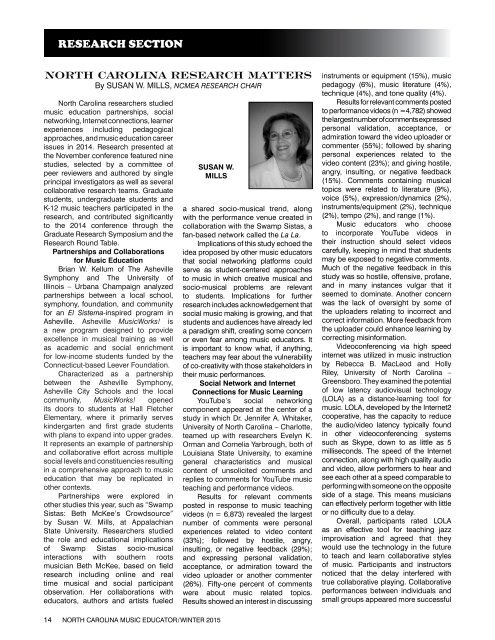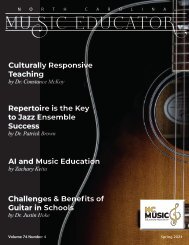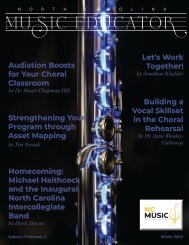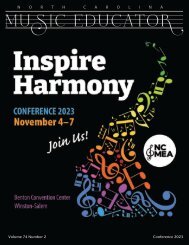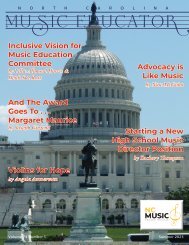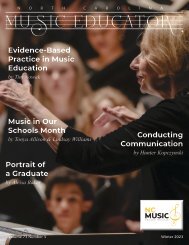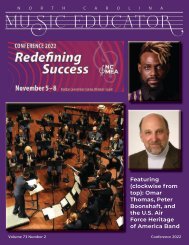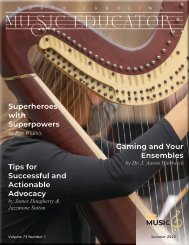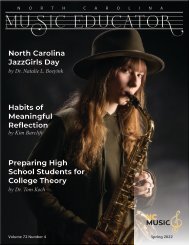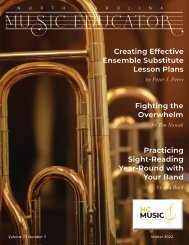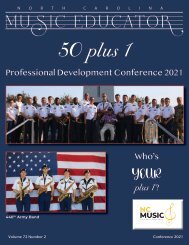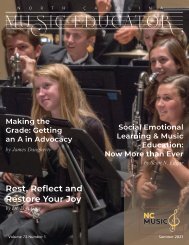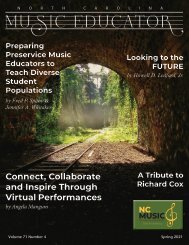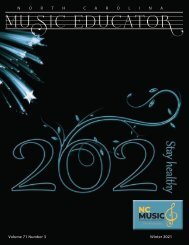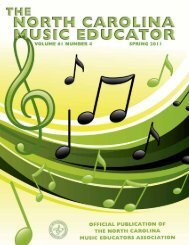NC Music Educator Winter 2015
North Carolina Music Educators Association Journal Winter 2015
North Carolina Music Educators Association Journal Winter 2015
You also want an ePaper? Increase the reach of your titles
YUMPU automatically turns print PDFs into web optimized ePapers that Google loves.
RESEARCH SECTION<br />
NORTH CAROLINA RESEARCH MATTERS<br />
By SUSAN W. MILLS, <strong>NC</strong>MEA RESEARCH CHAIR<br />
North Carolina researchers studied<br />
music education partnerships, social<br />
networking, Internet connections, learner<br />
experiences including pedagogical<br />
approaches, and music education career<br />
issues in 2014. Research presented at<br />
the November conference featured nine<br />
studies, selected by a committee of<br />
peer reviewers and authored by single<br />
principal investigators as well as several<br />
collaborative research teams. Graduate<br />
students, undergraduate students and<br />
K-12 music teachers participated in the<br />
research, and contributed significantly<br />
to the 2014 conference through the<br />
Graduate Research Symposium and the<br />
Research Round Table.<br />
Partnerships and Collaborations<br />
for <strong>Music</strong> Education<br />
Brian W. Kellum of The Asheville<br />
Symphony and The University of<br />
Illinois – Urbana Champaign analyzed<br />
partnerships between a local school,<br />
symphony, foundation, and community<br />
for an El Sistema-inspired program in<br />
Asheville. Asheville <strong>Music</strong>Works! is<br />
a new program designed to provide<br />
excellence in musical training as well<br />
as academic and social enrichment<br />
for low-income students funded by the<br />
Connecticut-based Leever Foundation.<br />
Characterized as a partnership<br />
between the Asheville Symphony,<br />
Asheville City Schools and the local<br />
community, <strong>Music</strong>Works! opened<br />
its doors to students at Hall Fletcher<br />
Elementary, where it primarily serves<br />
kindergarten and first grade students<br />
with plans to expand into upper grades.<br />
It represents an example of partnership<br />
and collaborative effort across multiple<br />
social levels and constituencies resulting<br />
in a comprehensive approach to music<br />
education that may be replicated in<br />
other contexts.<br />
Partnerships were explored in<br />
other studies this year, such as “Swamp<br />
Sistas: Beth McKee’s Crowdsource”<br />
by Susan W. Mills, at Appalachian<br />
State University. Researchers studied<br />
the role and educational implications<br />
of Swamp Sistas socio-musical<br />
interactions with southern roots<br />
musician Beth McKee, based on field<br />
research including online and real<br />
time musical and social participant<br />
observation. Her collaborations with<br />
educators, authors and artists fueled<br />
SUSAN W.<br />
MILLS<br />
a shared socio-musical trend, along<br />
with the performance venue created in<br />
collaboration with the Swamp Sistas, a<br />
fan-based network called the La La.<br />
Implications of this study echoed the<br />
idea proposed by other music educators<br />
that social networking platforms could<br />
serve as student-centered approaches<br />
to music in which creative musical and<br />
socio-musical problems are relevant<br />
to students. Implications for further<br />
research includes acknowledgement that<br />
social music making is growing, and that<br />
students and audiences have already led<br />
a paradigm shift, creating some concern<br />
or even fear among music educators. It<br />
is important to know what, if anything,<br />
teachers may fear about the vulnerability<br />
of co-creativity with those stakeholders in<br />
their music performances.<br />
Social Network and Internet<br />
Connections for <strong>Music</strong> Learning<br />
YouTube’s social networking<br />
component appeared at the center of a<br />
study in which Dr. Jennifer A. Whitaker,<br />
University of North Carolina – Charlotte,<br />
teamed up with researchers Evelyn K.<br />
Orman and Cornelia Yarbrough, both of<br />
Louisiana State University, to examine<br />
general characteristics and musical<br />
content of unsolicited comments and<br />
replies to comments for YouTube music<br />
teaching and performance videos.<br />
Results for relevant comments<br />
posted in response to music teaching<br />
videos (n = 6,873) revealed the largest<br />
number of comments were personal<br />
experiences related to video content<br />
(33%); followed by hostile, angry,<br />
insulting, or negative feedback (29%);<br />
and expressing personal validation,<br />
acceptance, or admiration toward the<br />
video uploader or another commenter<br />
(26%). Fifty-one percent of comments<br />
were about music related topics.<br />
Results showed an interest in discussing<br />
instruments or equipment (15%), music<br />
pedagogy (6%), music literature (4%),<br />
technique (4%), and tone quality (4%).<br />
Results for relevant comments posted<br />
to performance videos (n =4,782) showed<br />
the largest number of comments expressed<br />
personal validation, acceptance, or<br />
admiration toward the video uploader or<br />
commenter (55%); followed by sharing<br />
personal experiences related to the<br />
video content (23%); and giving hostile,<br />
angry, insulting, or negative feedback<br />
(15%). Comments containing musical<br />
topics were related to literature (9%),<br />
voice (5%), expression/dynamics (2%),<br />
instruments/equipment (2%), technique<br />
(2%), tempo (2%), and range (1%).<br />
<strong>Music</strong> educators who choose<br />
to incorporate YouTube videos in<br />
their instruction should select videos<br />
carefully, keeping in mind that students<br />
may be exposed to negative comments.<br />
Much of the negative feedback in this<br />
study was so hostile, offensive, profane,<br />
and in many instances vulgar that it<br />
seemed to dominate. Another concern<br />
was the lack of oversight by some of<br />
the uploaders relating to incorrect and<br />
correct information. More feedback from<br />
the uploader could enhance learning by<br />
correcting misinformation.<br />
Videoconferencing via high speed<br />
internet was utilized in music instruction<br />
by Rebecca B. MacLeod and Holly<br />
Riley, University of North Carolina –<br />
Greensboro. They examined the potential<br />
of low latency audiovisual technology<br />
(LOLA) as a distance-learning tool for<br />
music. LOLA, developed by the Internet2<br />
cooperative, has the capacity to reduce<br />
the audio/video latency typically found<br />
in other videoconferencing systems<br />
such as Skype, down to as little as 5<br />
milliseconds. The speed of the Internet<br />
connection, along with high quality audio<br />
and video, allow performers to hear and<br />
see each other at a speed comparable to<br />
performing with someone on the opposite<br />
side of a stage. This means musicians<br />
can effectively perform together with little<br />
or no difficulty due to a delay.<br />
Overall, participants rated LOLA<br />
as an effective tool for teaching jazz<br />
improvisation and agreed that they<br />
would use the technology in the future<br />
to teach and learn collaborative styles<br />
of music. Participants and instructors<br />
noticed that the delay interfered with<br />
true collaborative playing. Collaborative<br />
performances between individuals and<br />
small groups appeared more successful<br />
14 NORTH CAROLINA MUSIC EDUCATOR/WINTER <strong>2015</strong>


